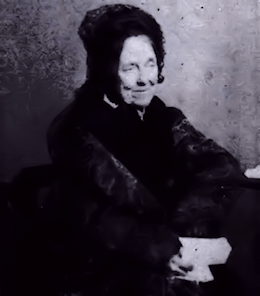Textus Receptus Bibles
Julia E. Smith Translation 1876
| 16:1 | And the sabbath having intervened, Mary Magdalene, and Mary of James, and Salome, bought spices, that having come, they might anoint him. |
| 16:2 | And very early in the morning of one of the sabbaths, they came to the tomb, the sun having risen. |
| 16:3 | And they said to themselves, Who shall roll away for us the stone from the door of the tomb? |
| 16:4 | And having looked up, they saw that the stone was rolled away: for it was very great. |
| 16:5 | And having come to the tomb, they saw a young man sitting on the right, being encompassed with a white robe; and they were terrified. |
| 16:6 | And he says to them, Be not terrified: Ye seek Jesus the Nazarene, being crucified: he was raised; he is not here: see the place where they laid him. |
| 16:7 | But retire ye; say to his disciples and to Peter that he goes before you into Galilee: there shall ye see him, as he said to you. |
| 16:8 | And having come forth quickly, they fled from the tomb; and terror and amazement held them: and they said nothing to any; for they were afraid. |
| 16:9 | And having risen early the first of the sabbath, he was manifested first to Mary Magdalene, from whom he had cast seven demons. |
| 16:10 | She having gone announced to them having been with him, grieving and weeping. |
| 16:11 | And they having heard that he lives, and was seen by her, believed not. |
| 16:12 | And after these things, to two of them, walking about, was he manifested in another form, they going into the field. |
| 16:13 | And they having come announced to the rest: neither did they believe them. |
| 16:14 | Afterwards to those reclining at table was he manifested, and he reproached their unbelief and hard heart, because they believed not them having seen him raised. |
| 16:15 | And he said to them, Having gone into all the world proclaim the good news to all creation. |
| 16:16 | And he having believed and having been immersed shall be saved; but he not having believed shall be condemned. |
| 16:17 | And these signs shall follow those having believed; In my name they shall cast out demons; they shall speak with new tongues; |
| 16:18 | They shall take up serpents; and should they drink any deadly thing, it shall not hurt them; they shall put hands upon the sick, and they shall be well. |
| 16:19 | Truly therefore the Lord, after ho had spoken to them, was taken up into the heavens, and sat on the right hand of God. |
| 16:20 | And they, having gone forth, proclaimed every where, the Lord performing together, and confirming the word by signs following. Amen. |

Julia E. Smith Translation 1876
The Julia Evelina Smith Parker Translation is considered the first complete translation of the Bible into English by a woman. The Bible was titled The Holy Bible: Containing the Old and New Testaments; Translated Literally from the Original Tongues, and was published in 1876.
Julia Smith, of Glastonbury, Connecticut had a working knowledge of Latin, Greek and Hebrew. Her father had been a Congregationalist minister before he became a lawyer. Having read the Bible in its original languages, she set about creating her own translation, which she completed in 1855, after a number of drafts. The work is a strictly literal rendering, always translating a Greek or Hebrew word with the same word wherever possible. Smith accomplished this work on her own in the span of eight years (1847 to 1855). She had sought out no help in the venture, even writing, "I do not see that anybody can know more about it than I do." Smith's insistence on complete literalness, plus an effort to translate each original word with the same English word, combined with an odd notion of Hebrew tenses (often translating the Hebrew imperfect tense with the English future) results in a translation that is mechanical and often nonsensical. However, such a translation if overly literal might be valuable to consult in checking the meaning of some individual verse. One notable feature of this translation was the prominent use of the Divine Name, Jehovah, throughout the Old Testament of this Bible version.
In 1876, at 84 years of age some 21 years after completing her work, she finally sought publication. The publication costs ($4,000) were personally funded by Julia and her sister Abby Smith. The 1,000 copies printed were offered for $2.50 each, but her household auction in 1884 sold about 50 remaining copies.
The translation fell into obscurity as it was for the most part too literal and lacked any flow. For example, Jer. 22:23 was given as follows: "Thou dwelling in Lebanon, building as nest in the cedars, how being compassionated in pangs coming to thee the pain as in her bringing forth." However, the translation was the only Contemporary English translation out of the original languages available to English readers until the publication of The British Revised Version in 1881-1894.(The New testament was published in 1881, the Old in 1884, and the Apocrypha in 1894.) This makes it an invaluable Bible for its period.